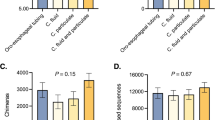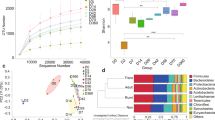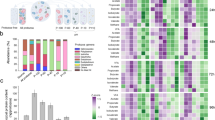Abstract
IT has been suggested that the bacterial flora of the rumen should be considered as three distinct, interacting populations—the bacteria of rumen fluid (the population which has been studied most extensively), the bacteria associated with food particles, and the bacteria adhering to the epithelial wall of the organ1. Until now, studies of the ‘epithelial’ population have been restricted to examination of postmortem samples of wall tissue and its attached bacterial flora2–5. A recently developed technique6 for feeding young sheep for long periods solely by infusion of protein and other essential nutrients into the abomasum, and of volatile fatty acids and bicarbonate buffer into the rumen, has provided us with an opportunity to study in isolation the role of the bacterial population of the wall in the ecomicrobiology of the rumen in the living animal. Our studies show that this population can exist independently of the other two populations, that it is primarily responsible for urea digestion in the rumen and that it initiates breakdown of dead epithelial tissue. Furthermore, our results point to an inverse relationship between ammonia concentration and ureolytic activity in rumen fluid, which may account for the control which ammonia exerts over flux of urea across the rumen wall7–9.
This is a preview of subscription content, access via your institution
Access options
Subscribe to this journal
Receive 51 print issues and online access
$199.00 per year
only $3.90 per issue
Buy this article
- Purchase on Springer Link
- Instant access to full article PDF
Prices may be subject to local taxes which are calculated during checkout
Similar content being viewed by others
References
Cheng, K.-J., McCowan, R. P. & Costerton, J. W. Am. J. clin. Nutr. 32, 139–148 (1979).
Bauchop, T., Clarke, R. T. J. & Newhook, J. C. Appl. Microbiol. 30, 668–675 (1975).
Cheng, K.-J., Akin, D. E. & Costerton, J. W. Fedn Proc. 36, 193–197 (1977).
McCowan, R. P., Cheng, K.-J., Bailey, C. B. M. & Costerton, J. W. Appl. Environ. Microbiol. 35, 149–155 (1978).
Cheng, K.-J., Bailey, C. B. M., Hironaka, R. & Costerton, J. W. Can. J. Anim. Sci. (in the press).
Ørskov, E. R., Grubb, D. A., Wenham, G. & Corrigall, W. Br. J. Nutr. 41 (in the press).
Varady, J., Boda, K., Havassy, I. & Bajo, M. Physiologia bohemoslov. 18, 23–27 (1969).
Harrop, C. J. F. & Phillipson, A. T. J. agric. Sci., Camb. 82, 399–408 (1974).
Kennedy, P. M. & Milligan, L. P. Br. J. Nutr. 40, 149–154 (1978).
Bryant, M. P. Dukes' Physiology of Domestic Animals, 8th edn (ed. Swenson, M. J.) 484–515 (Cornell University Press, Ithaca, 1970).
Cook, A. R. J. gen. Microbiol. 92, 32–48 (1976).
Caffrey, P. J., Hatfield, E. E., Norton, H. W. & Garrigus, U. S. J. Anim. Sci. 26, 595–600 (1967).
Jones, G. A. Can. J. Microbiol. 14, 409–416 (1968).
Chalupa, W., Clark, J., Opliger, P. & Lavker, R. J. Nutr. 100, 161–169 (1970).
Brent, B. E., Adepoju, A. & Portela, F. J. Anim. Sci. 32, 794–798 (1971).
Mann, S. O., Masson, F. M. & Oxford, A. E. J. gen. Microbiol. 10, 142–149 (1954).
Appleby, J. C. J. gen. Microbiol. 12, 526–533 (1955).
Mann, S. O. & Oxford, A. E. J. gen. Microbiol. 12, 140–146 (1955).
Blackburn, T. H. & Hobson, P. N. J. gen. Microbiol. 29, 69–81 (1962).
Muhrer, M. E. & Carroll, E. J. J. Anim. Sci. 23, 885 (1964).
van Wyk, K. & Steyn, P. L. J. gen. Microbiol. 91, 225–232 (1975).
Bergey's Manual of Determinative Bacteriology, 8th edn, 478–489 (Williams and Wilkins, Baltimore, 1974).
Chapman, G. H. J. Bact. 51, 409–410 (1946).
Mann, S. O. & Stewart, C. S. J. gen. Microbiol. 84, 379–382 (1974).
Pennington, R. J. Biochem. J. 56, 410–416 (1954).
Abdel Rahman, S. & Decker, P. Nature 209, 618–619 (1966).
Jones, G. A. in Urea as a Protein Supplement, (ed. Briggs, M. H.) 111–124 (Pergamon, New York, 1967).
Chalupa, W. Fedn Proc. 31, 1152–1164 (1972).
Jones, G. A., MacLeod, R. A. & Blackwood, A. C. Can. J. Microbiol. 10, 371–378 (1964).
Houpt, T. R. & Houpt, K. A. Am. J. Physiol. 214, 1296–1303 (1968).
Engelhardt, W. V. & Nickel, W. Archs ges. Physiol. 286, 57–75 (1965).
Mann, S. O. J. appl. Bact. 31, 241–244 (1968).
Hobson, P. N. Meth. Microbiol. 3 B, 117–132 (1969).
Hungate, R. E. Meth. Microbiol. 3 B, 133–149 (1969).
Weatherburn, M. W. Analyt. Chem. 39, 971–974 (1967).
Luft, J. H. Anat. Rec. 171, 369–416 (1971).
Author information
Authors and Affiliations
Rights and permissions
About this article
Cite this article
WALLACE, R., CHENG, KJ., DINSDALE, D. et al. An independent microbial flora of the epithelium and its role in the ecomicrobiology of the rumen. Nature 279, 424–426 (1979). https://doi.org/10.1038/279424a0
Received:
Accepted:
Published:
Issue Date:
DOI: https://doi.org/10.1038/279424a0
This article is cited by
-
Understanding host-microbial interactions in rumen: searching the best opportunity for microbiota manipulation
Journal of Animal Science and Biotechnology (2017)
-
PCR-DGGE analysis of bacterial population attached to the bovine rumen wall
Folia Microbiologica (2010)
Comments
By submitting a comment you agree to abide by our Terms and Community Guidelines. If you find something abusive or that does not comply with our terms or guidelines please flag it as inappropriate.



